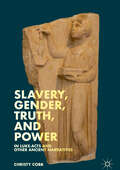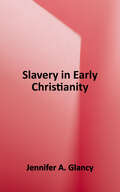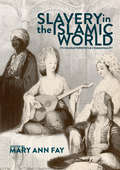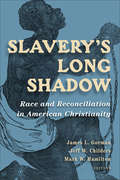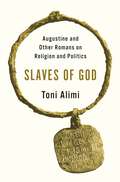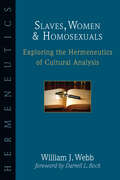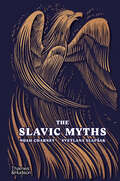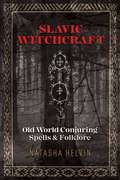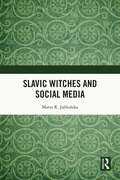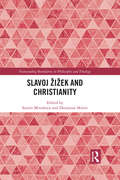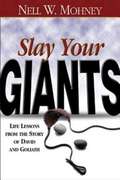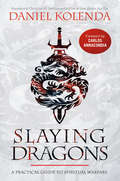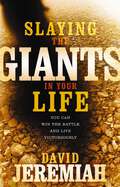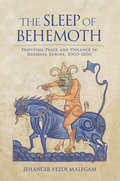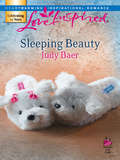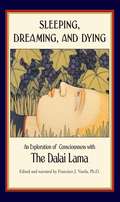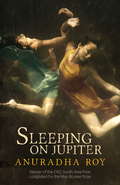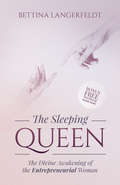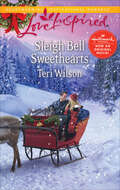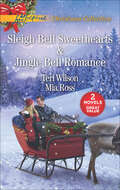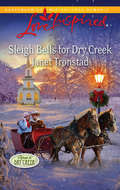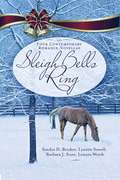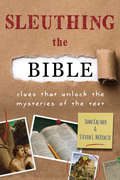- Table View
- List View
Slavery, Gender, Truth, and Power in Luke-Acts and Other Ancient Narratives
by Christy CobbThis book examines slavery and gender through a feminist reading of narratives including female slaves in the Gospel of Luke, the Acts of the Apostles, and early Christian texts. Through the literary theory of Mikhail Bakhtin, the voices of three enslaved female characters—the female slave who questions Peter in Luke 22, Rhoda in Acts 12, and the prophesying slave of Acts 16—are placed into dialogue with female slaves found in the Apocryphal Acts, ancient novels, classical texts, and images of enslaved women on funerary monuments. Although ancients typically distrusted the words of slaves, Christy Cobb argues that female slaves in Luke-Acts speak truth to power, even though their gender and status suggest that they cannot. In this Bakhtinian reading, female slaves become truth-tellers and their words confirm aspects of Lukan theology. This exegetical, theoretical, and interdisciplinary book is a substantial contribution to conversations about women and slaves in Luke-Acts and early Christian literature.
Slavery in Early Christianity
by Jennifer A. GlancyThis is the first paperback edition of the enlightening Oxford University hardcover published in 2002. Glancy here situates early Christian slavery in its broader cultural setting, arguing that modern scholars have consistently underestimated the pervasive impact of slavery on the institutional structures, ideologies, and practices of the early churches - and upon the bodies of the enslaved. Her careful attention to the bodily experience of subjection and violation that constituted slavery makes this an indispensable book for anyone interested in slavery in early Christianity. Includes special chapters on Jesus and Paul.
Slavery in the Islamic World: Its Characteristics and Commonality
by Mary Ann FayThis edited volume determines where slavery in the Islamic world fits within the global history of slavery and the various models that have been developed to analyze it. To that end, the authors focus on a question about Islamic slavery that has frequently been asked but not answered satisfactorily, namely, what is Islamic about slavery in the Islamic world. Through the fields of history, sociology, literature, women's studies, African studies, and comparative slavery studies, this book is an important contribution to the scholarly research on slavery in the Islamic lands, which continues to be understudied and under-represented in global slavery studies.
Slavery's Long Shadow: Race and Reconciliation in American Christianity
by James L. Gorman Jeff W. Childers Mark W. HamiltonHow interactions of race and religion have influenced unity and division in the church At the center of the story of American Christianity lies an integral connection between race relations and Christian unity. Despite claims that Jesus Christ transcends all racial barriers, the most segregated hour in America is still Sunday mornings when Christians gather for worship. In Slavery’s Long Shadow fourteen historians and other scholars examine how the sobering historical realities of race relations and Christianity have created both unity and division within American churches from the 1790s into the twenty-first century. The book’s three sections offer readers three different entry points into the conversation: major historical periods, case studies, and ways forward. Historians as well as Christians interested in racial reconciliation will find in this book both help for understanding the problem and hope for building a better future.Contributors:Tanya Smith BriceJoel A. BrownLawrence A. Q. BurnleyJeff W. ChildersWes CrawfordJames L. GormanRichard T. HughesLoretta HunnicuttChristopher R. HutsonKathy PulleyEdward J. RobinsonKamilah Hall SharpJerry TaylorD. Newell Williams
Slaves of God: Augustine and Other Romans on Religion and Politics
by Toni AlimiA provocative look at the central role of slavery in Augustine&’s religious, ethical, and political thoughtAugustine believed that slavery is permissible, but to understand why, we must situate him in his late antique Roman intellectual context. Slaves of God provides a major reassessment of this monumental figure in the Western religious and political tradition, tracing the remarkably close connections between Augustine&’s understanding of slavery and his broader thought.Augustine is most often read through the lens of Greek philosophy and the theology of Christian writers such as Paul and Ambrose, yet his debt to Roman thought is seldom appreciated. Toni Alimi reminds us that the author of Confessions and City of God was also a Roman citizen and argues that some of the thinkers who most significantly shaped his intellectual development were Romans such as Cicero, Seneca, Lactantius, and Varro—Romans who had much to say about slavery and its relationship to civic life. Alimi shows how Augustine, a keen and influential student of these figures, related chattel slavery and slavery to God, and sheds light on Augustinianism&’s complicity in Christianity&’s long entanglement with slavery.An illuminating work of scholarship, Slaves of God reveals how slavery was integral to Augustine&’s views about law, rule, accountability, and citizenship, and breaks new ground on the topic of slavery in late antique and medieval political thought.
Slaves, Women and Homosexuals: Exploring the Hermeneutics of Cultural Analysis
by William J. WebbIn Slaves, Women Homosexuals William J. Webb tackles some of the most complex and controversial issues that have challenged the Christian church--and still do. He leads you through the maze of interpretation that has historically surrounded understanding of slaves, women and homosexuals, and he evaluates various approaches to these and other biblical-ethical teachings. Throughout, Webb attempts to "work out the hermeneutics involved in distinguishing that which is merely cultural in Scripture from that which is timeless" (Craig A. Evans). By the conclusion, Webb has introduced and developed a "redemptive hermeneutic" that can be applied to many issues that cause similar dilemmas. Darrel L. Bock writes in the foreword to Webb's work, "His goal is not only to discuss how these groups are to be seen in light of Scriptures but to make a case for a specific hermeneutical approach to reading these texts. . . . This book not only advances a discussion of the topics, but it also takes a markedly new direction toward establishing common ground where possible, potentially breaking down certain walls of hostility within the evangelical community."
The Slavic Myths
by Noah Charney Svetlana SlapšakA Pulitzer-nominated author and one of the great public intellectuals of Slavic culture bring to life the unfamiliar myths and legends of the Slavic world. In the first collection of Slavic myths for an international readership, Noah Charney and Svetlana Slapšak expertly weave together the ancient stories with nuanced analysis to illuminate their place at the heart of Slavic tradition. While Slavic cultures are far-ranging, comprised of East Slavs (Russia, Ukraine, Belarus), West Slavs (the Czech Republic, Slovakia, Poland), and South Slavs (the countries of former Yugoslavia plus Bulgaria), they are connected by tales of adventure and magic with roots in a common lore. In the world of Slavic mythology we find petulant deities, demons and fairies, witches, and a supreme god who can hurl thunderbolts. Gods gather under the World Tree, reminiscent of Norse mythology’s Yggdrasill. The vampire—usually the only Serbo-Croatian word in any foreign-language dictionary—and the werewolf both emerge from Slavic belief. In their careful analysis and sensitive reconstructions of the myths, Charney and Slapšak unearth the Slavic beliefs before their distortion first by Christian chroniclers and then by nineteenth-century scholars seeking origin stories for their newborn nation states. They reveal links not only to the neighboring pantheons of Greece, Rome, Egypt, and Scandinavia, but also the belief systems of indigenous peoples of Australia, the Americas, Africa, and Asia. Specially commissioned illustrations inspired by traditional Eastern and European folk art bring the stories and their cultural landscape to life.
Slavic Witchcraft: Old World Conjuring Spells and Folklore
by Natasha HelvinA practical guide to the ancient magical tradition of Russian sorcery and Eastern Slavic magical rites • Offers step-by-step instructions for more than 300 spells, incantations, charms, amulets, and practical rituals for love, career success, protection, healing, divination, communicating with spirits and ancestors, and other challenges and situations • Reveals specific places of magical power in the natural world as well as the profound power of graveyards and churches for casting spells • Explores the folk history of this ancient magical tradition, including how the pagan gods gained new life as Eastern Orthodox saints, and shares folktales of magical beings, including sorceresses shapeshifting into animals and household objects Passed down through generations, the Slavic practice of magic, witchcraft, and sorcery is still alive and well in Russia, the Ukraine, and Belarus, as well as the Balkans and the Baltic states. There are still witches who whisper upon tied knots to curse or heal, sorceresses who shapeshift into animals or household objects, magicians who cast spells for love or good fortune, and common folk who seek their aid for daily problems big and small. Sharing the extensive knowledge she inherited from her mother and grandmother, including spells of the “Old Believers” previously unknown to outsiders, Natasha Helvin explores in detail the folk history and practice of Russian sorcery and Eastern Slavic magical rites, offering a rich compendium of more than 300 spells, incantations, charms, and practical rituals for love, relationships, career success, protection, healing, divination, averting the evil eye, communicating with spirits and ancestors, and a host of other life challenges and daily situations, with complete step-by-step instructions to ensure your magical goals are realized. She explains how this tradition has only a thin Christian veneer over its pagan origins and how the Slavic pagan gods and goddesses acquired new lives as the saints of the Eastern Orthodox Church. She details how the magical energy for these spells and rituals is drawn from the forces of nature, revealing specific places of power in the natural world as well as the profound power of graveyards and churches for casting spells. She explores the creation of amulets and talismans, the importance of icons, and the proper recital of magical language and actions during spells, as well as how one becomes a witch or sorceress. Offering a close examination of these two-thousand-year-old occult practices, Helvin also includes Slavic folk advice, adapted for the modern era. Revealing what it means to be a Slavic witch or sorceress, and how this vocation pervades all aspects of life, she shows that each of us has magic within that we can use to take control of our own destiny.
Slavic Witches and Social Media
by Marta R. JabłońskaSlavic Witches and Social Media examines the role of social media in the spiritual practices of modern Slavic witches and draws a comparative analysis between contemporary neopaganism and Catholicism in Poland. This volume presents a fresh and comprehensive examination of Slavic witches within the context of the growing popularity of neopagan religions and the integration of social media in religious practices. It delves into contemporary witchcraft in Poland, including the prominent Wicca tradition, native Slavic beliefs with their diverse pantheon of deities, extensive demonology, and profound respect for nature, as well as individual, eclectic paths. Through a digital religion study, this book investigates how neopagans and Catholics incorporate social media into their spiritual journeys. Its vivid portrait of a Slavic witch provides a deeper understanding of their beliefs, practices, and engagement with social media platforms. This book is dedicated to scholars in the field of religious sociology, digital religion, and ethnography with a deep fascination for exploring folk magic and Slavic traditions and their adaptation to the emerging digital landscape. It is an insightful resource for researchers in theology, communication, and new media, as well as for all researchers and individuals who share an interest in the captivating realm of contemporary witches and witchcraft.
Slavoj Žižek and Christianity (Transcending Boundaries in Philosophy and Theology)
by Sotiris Mitralexis Dionysios SklirisSlavoj Žižek’s critical engagement with Christian theology goes much further than his seminal The Fragile Absolute (2000), or his The Puppet and the Dwarf (2003), or even his discussion with noted theologian John Milbank in The Monstrosity of Christ (2009). His reading of Christianity, utilising his signature elements of Lacanian psychoanalysis and Hegelian philosophy with modern philosophical currents, can be seen as a genuinely original contribution to the philosophy of religion. This book focuses on these aspects of Žižek’s thought with either philosophy and cultural theory, or Christian theology, serving as starting points of enquiry. Written by a panel of international contributors, each chapter teases out various strands of Žižek’s thought concerning Christianity and religion and brings them into a wider conversation about the nature of faith. These essays show that far from being an outright rejection of Christian thought and intellectual heritage, Žižek’s work could be seen as a perverse affirmation thereof. Thus, what he has to say should be of direct interest to Christian theology itself. Touching on thinkers such as Badiou, Lacan, Chesterton and Schelling, this collection is a dynamic reading and re-reading of Žižek’s relationship to Christianity. As such, scholars of theology, the philosophy of religion and Žižek more generally will all find this book to be of great interest.
Slay Your Giants: Life Lessons from the Story of David and Goliath
by Nell W. MohneyThis book by popular author Nell W. Mohney, draws from the biblical story of David and Goliath, offering readers inspiration and encouragement for facing and defeating the spiritual "giants" in their lives such as: grief, depression, procrastination, stress, perfectionism, anger and resentment, jealousy, lust, and loneliness. Questions are provided at the end of each chapter to help individuals and groups "dig a little deeper."
Slaying Dragons: A Practical Guide to Spiritual Warfare
by Daniel KolendaThe real fight is the one you can't see. The supernatural realm is very real, and it directly impacts our day-to-day lives. Often spiritual battles lie behind our everyday struggles. Though the spiritual world is invisible, we are not unaware of the enemy&’s schemes. Through God&’s Word and the power of the Holy Spirit we are equipped to be more than conquerors through Christ! With doctrinally sound, practical teaching, Slaying Dragons shows how the demonic realm fits into orthodox thoughts on salvation, redemption, and kingdom life. Daniel Kolenda demystifies spiritual warfare to shine light on what the enemy is doing in readers&’ lives and what they can do to slay every dragon they encounter. It also contains real-world examples of encounters with spiritual darkness, demonstrating examples of how &“the light shines in the darkness, and the darkness has not overcome it&” (John 1:5, NIV). It&’s easy to lose sight of the big picture as we focus on our everyday struggles. But our daily battles are part of a much bigger war, and we have been given all we need to win. Slaying Dragons will show readers what the enemy is trying to accomplish and how they can slay every dragon they encounter—in their lives and in the world.This book will teach you to see and overcome the spiritual battles behind your everyday struggles. Also Available in Spanish ISBN: 978-1-62999-283-9Other Books by Daniel Kolenda:Live Before You Die (2013) ISBN: 978-1616387167
Slaying the Giants in Your Life: You Can Win the Battle and Live Victoriously
by David JeremiahGiants plague today's church. And while they may not wield spears and shields, they are fearsome, causing far too many of God's children to stumble in their walks. In Slaying the Giants in Your Life, Dr. David Jeremiah challenges us to stand valiantly against the giants that seek to terrorize today's believers. Dr. Jeremiah's biblical Who's Who of truth warriors will encourage you. Throughout the text, Dr. Jeremiah weaves gripping, real-life stories of contemporary giant slayers who came face-to-face with their own Goliaths: temptation, doubt, procrastination, and jealousy. In each, you will discover afresh the eternal unwavering promise of God to overcome those giants.
The Sleep of Behemoth: Disputing Peace and Violence in Medieval Europe, 1000–1200
by Jehangir Yezdi MalegamIn The Sleep of Behemoth, Jehangir Yezdi Malegam explores the emergence of conflicting concepts of peace in western Europe during the High Middle Ages. Ever since the Early Church, Christian thinkers had conceived of their peace separate from the peace of the world, guarded by the sacraments and shared only grudgingly with powers and principalities. To kingdoms and communities they had allowed attenuated versions of this peace, modes of accommodation and domination that had tranquility as the goal. After 1000, reformers in the papal curia and monks and canons in the intellectual circles of northern France began to reimagine the Church as an engine of true peace, whose task it was eventually to absorb all peoples through progressive acts of revolutionary peacemaking. Peace as they envisioned it became a mandate for reform through conflict, coercion, and insurrection. And the pursuit of mere tranquility appeared dangerous, and even diabolical.As Malegam shows, within western Christendom's major centers of intellectual activity and political thought, the clergy competed over the meaning and monopolization of the term "peace." contrasting it with what one canon lawyer called the "sleep of Behemoth," a diabolical "false" peace of lassitude and complacency, one that produced unsuitable forms of community and friendship that must be overturned at all costs. Out of this contest over the meaning and ownership of true peace, Malegam concludes, medieval thinkers developed theologies that shaped secular political theory in the later Middle Ages. The Sleep of Behemoth traces this radical experiment in redefining the meaning of peace from the papal courts of Rome and the schools of Laon, Liege, and Paris to its gradual spread across the continent and its impact on such developments as the rise of papal monarchism; the growth of urban, communal self-government; and the emergence of secular and mystical scholasticism.
Sleeping Beauty
by Judy BaerWill Suze Sleepwalk Into The Arms Of Her Dream Man?Chronic sleepwalker Suze Charles's nocturnal rambles were legendary among her friends and family. But then she was up for a promotion in her career as an insurance adjuster. And it was anyone's guess whether her sleep would prevent her from thriving in a new work environment--or from finding a husband. During a business trip to Chicago, Suze met sleep disorder specialist David Grant--while she was in a sleepwalking trance! She was sure Grant was the man of her dreams--he was even unfazed by her Terror Twin nephews! But does the independent bachelor's interest in Suze go beyond a mere case study?
Sleeping, Dreaming, and Dying
by Thupten Jinpa His Holiness the Dalai Lama B. Alan Wallace Francisco J VarelaThis is an absorbing account of a dialogue between leading Western scientists and the foremost representative of Buddhism today, the Dalai Lama of Tibet. For modern science, the transitional states of consciousness lie at the forefront of research in many fields. For a Buddhist practitioner these same states present crucial opportunities to explore and transform consciousness itself. This book is the account of a historic dialogue between leading Western scientists and the Dalai Lama of Tibet. Revolving around three key moments of consciousness--sleep, dreams, and death--the conversations recorded here are both engrossing and highly readable. Whether the topic is lucid dreaming, near-death experiences, or the very structure of consciousness itself, the reader is continually surprised and delighted. Narrated by Francisco Varela, an internationally recognized neuroscientist, the book begins with insightful remarks on the notion of personal identity by noted philosopher Charles Taylor, author of the acclaimed Sources of Self. This sets the stage for Dr. Jerome Engel, Dr. Joyce MacDougal, and others to engage in extraordinary exchanges with the Dalai Lama on topics ranging from the neurology of sleep to the yoga of dreams. Remarkable convergences between the Western scientific tradition and the Buddhist contemplative sciences are revealed. Dr. Jayne Gackenbach's discussion of lucid dreaming, for example, prompts a detailed and fascinating response from the Dalai Lama on the manipulation of dreams by Buddhist meditators. The conversations also reveal provocative divergences of opinion, as when the Dalai Lama expresses skepticism about "Near-Death Experiences" as presented by Joan Halifax. The conversations are engrossing and highly readable. Any reader interested in psychology, neuroscience, Buddhism, or the alternative worlds of dreams will surely enjoy Sleeping, Dreaming, and Dying.
Sleeping on Jupiter: A Novel
by Anuradha RoyLONGLISTED FOR THE MAN BOOKER PRIZE 2015A stark and unflinching novel by a spellbinding storyteller, about religion, love and violence in the modern world.A train stops at a railway station. A young woman jumps off. She has wild hair, sloppy clothes, a distracted air. She looks Indian, yet she is somehow not. The sudden violence of what happens next leaves the other passengers gasping.The train terminates at Jarmuli, a temple town by the sea. Here, among pilgrims, priests and ashrams, three old women disembark only to encounter the girl once again. What is someone like her doing in this remote corner, which attracts only worshippers?Over the next five days, the old women live out their long-planned dream of a holiday together; their temple guide finds ecstasy in forbidden love; and the girl is joined by a photographer battling his own demons.The full force of the evil and violence beneath the serene surface of the town becomes evident when their lives overlap and collide. Unexpected connections are revealed between devotion and violence, friendship and fear, as Jarmuli is revealed as a place with a long, dark past that transforms all who encounter it.
Sleeping on Jupiter
by Anuradha RoyLONGLISTED FOR THE MAN BOOKER PRIZE 2015A stark and unflinching novel by a spellbinding storyteller, about religion, love and violence in the modern world.A train stops at a railway station. A young woman jumps off. She has wild hair, sloppy clothes, a distracted air. She looks Indian, yet she is somehow not. The sudden violence of what happens next leaves the other passengers gasping.The train terminates at Jarmuli, a temple town by the sea. Here, among pilgrims, priests and ashrams, three old women disembark only to encounter the girl once again. What is someone like her doing in this remote corner, which attracts only worshippers?Over the next five days, the old women live out their long-planned dream of a holiday together; their temple guide finds ecstasy in forbidden love; and the girl is joined by a photographer battling his own demons.The full force of the evil and violence beneath the serene surface of the town becomes evident when their lives overlap and collide. Unexpected connections are revealed between devotion and violence, friendship and fear, as Jarmuli is revealed as a place with a long, dark past that transforms all who encounter it.
The Sleeping Queen: The Divine Awakening of the Entrepreneurial Woman
by Bettina LangerfeldtThe Sleeping Queen is a timely message that offers a fresh perspective on the role of the woman entrepreneur as a powerful contributor to the prosperity level of families, communities, and economies worldwide. It unveils myths about feminine entrepreneurship that have been silently accepted for centuries and banished women to a place of little or no relevance in their society. It also sheds new light on the spirituality of entrepreneurship, money and wealth creation by women, and offers an eye-opening, biblical viewpoint of why women can and should fulfill their authentic role as feminine influencers. The reader of this book will discover the amazing contribution a woman was created to make to society with her unique feminine gifts and the priceless enrichment her divine calling to the business world is meant to have. As you journey through these pages you’ll experience how historical barriers that have deterred women for ages from engaging in successful feminine enterprises are exposed and broken. The sleeping queen inside of you will awaken! Your mindset about true womanhood and female entrepreneurship will be powerfully renewed. You will feel inspired and released to confidently step into the God-given position of empowered leadership and wealth creation you were always meant to have.
Sleigh Bell Sweethearts
by Teri WilsonNow a Hallmark Channel Original Movie - Northern Lights of ChristmasSecond Chance Yuletide Owning her own plane is all charter pilot Zoey Hathaway's ever dreamed of. So when she inherits a struggling reindeer farm, with three dozen unruly reindeer and one dangerously attractive ranch hand, Zoey's well-crafted plans seem to fly out the window. Now she must put her trust in Alec Wynn, and hope that the troubled cowboy's past won't interfere with her plans to save the farm. Zoey knows that if she wants to succeed, she can't do everything on her own. But as she accepts Alec's help, she'll soon realize it's not just her farm that's at stake-but her heart.
Sleigh Bell Sweethearts & Jingle Bell Romance: Sleigh Bell Sweethearts Jingle Bell Romance
by Teri Wilson Mia RossCelebrate the holidays with these heartwarming romancesSleigh Bell Sweethearts by Teri WilsonNow a Hallmark Channel Original Movie - Northern Lights of ChristmasOwning a plane is all pilot Zoey Hathaway’s ever dreamed of. So when she inherits a reindeer farm, Zoey’s plans fly out the window. Now she must put her trust in Alec Wynn and hope his past won’t interfere with her plans for the farm. But as she accepts Alec’s help, she’ll soon realize it’s not just her farm that’s at stake—but her heart.Jingle Bell Romance by Mia RossJulia Stanton loves Christmas—almost as much as she loves the home she’s made. So when her pastor’s prodigal son returns for a brief visit, she hatches a plan to keep Nick McHenry in town. Julia never expects to feel the spark of something more for Nick. But it will take more than attraction to turn this scrooge into her hometown hero.
Sleigh Bells for Dry Creek
by Janet TronstadRodeo rider Wade Stone never thought he'd step foot in Dry Creek, Montana, again. Not with his family's harrowing past. But nine years later, he's back on the Stone ranch and getting stared down by the townspeople. Except by Amy Mitchell, whose heart he broke after one sweet kiss. Wade knows she's afraid he'll leave again, but surely there's no second chance for them. It seems the whole town-and her family-is against them. Until one beautiful Christmas sleigh teaches everyone the true meaning of the holiday.
Sleigh Bells Ring: Four Contemporary Romance Novellas (Sleigh Bells Ring Ser.)
by Sandra D. BrickerSanta Claus is coming to town, and so are the Tucker sisters.Never mind a pony. The Tucker girls have inherited their father's horse farm for Christmas. Make that a run-down horse farm. It needs some serious TLC in order to make it sell-ready. Joanna knows that by recruiting her sisters and one handsome ranch hand they can fix up the place and even celebrate one last Christmas while they're at it. However, to Isabella, returning to their home in Kentucky bluegrass country for Christmas seems like an impossible hurdle. Can her Chicago boyfriend make life merry and bright again? One thing's for sure: nothing is peace on earth for Sophia as a new beau brings up old wounds. And when the fate of the horse farm is put in jeopardy because Amy accidentally fraternizes with the enemy, tensions rise. But it's not like the land developer stole Christmas . . . just her heart.Can the Tucker sisters have themselves a merry little Christmas?
Sleuthing the Bible: Clues That Unlock the Mysteries of the Text
by John Kaltner Steven L. McKenzieWhy is there crime-scene tape on my Bible? Elementary, my dear reader.There is an element of detective work to biblical scholarship that entails sniffing out and interpreting clues that often escape the notice of readers. John Kaltner and Steven L. McKenzie introduce the art of sleuthing the Bible, providing the necessary training to hunt for clues and piece them together to understand the larger picture.Sleuthing the Bible helps answer questions that occur during thoughtful examination of the Bible and provides exercises enabling readers to work through biblical passages on their own. Kaltner and McKenzie analyze two kinds of clues: (1) Smoking Guns— those that are obvious upon any close reading of biblical texts, and (2) Dusting for Prints—those that are more subtle or hidden from nonspecialists because of their unfamiliarity with the languages, culture, and larger content of the Bible.Written in a jargon-free and accessible style, Sleuthing the Bible is an ideal resource for anyone who wants to dig deeper into the biblical text.
Sleuthing the Bible: Clues That Unlock the Mysteries of the Text
by John Kaltner Steven L. McKenzieWhy is there crime-scene tape on my Bible? Elementary, my dear reader.There is an element of detective work to biblical scholarship that entails sniffing out and interpreting clues that often escape the notice of readers. John Kaltner and Steven L. McKenzie introduce the art of sleuthing the Bible, providing the necessary training to hunt for clues and piece them together to understand the larger picture.Sleuthing the Bible helps answer questions that occur during thoughtful examination of the Bible and provides exercises enabling readers to work through biblical passages on their own. Kaltner and McKenzie analyze two kinds of clues: (1) Smoking Guns— those that are obvious upon any close reading of biblical texts, and (2) Dusting for Prints—those that are more subtle or hidden from nonspecialists because of their unfamiliarity with the languages, culture, and larger content of the Bible.Written in a jargon-free and accessible style, Sleuthing the Bible is an ideal resource for anyone who wants to dig deeper into the biblical text.
